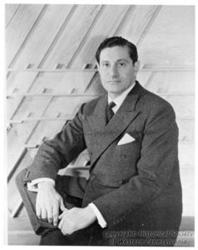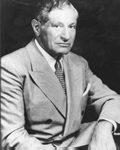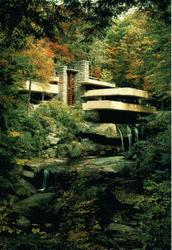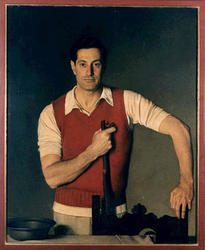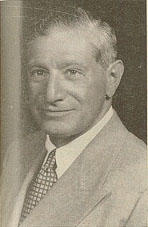| About Edgar Jonas Kaufmann, Sr.
Please sign in to see more. Edgar Jonas Kaufmann, Sr.(November 1, 1885-April 15, 1955) was a prominent US businessman and philanthropist who owned Kaufmann's, the best-known department store in Pittsburgh, Pennsylvania in the twentieth century. Kaufmann Department Stores later merged in 1946 with May Department Stores, eventually in 2006 it became Macy's.
Mr. Kaufmann employed architect Frank Lloyd Wright(1867-1959) to design a weekend home; the result was Fallingwater, near Mill Run (about 50 miles southeast of Pittsburgh). Being the original owner of Fallingwater has generated more widespread interest in Mr. Kaufmann than any other of his endeavors and accomplishments. A special relationship developed between the famed architect and Kaufmann. He also commissioned Richard Joseph Neutra(1892-1970) to build another landmark house for him: Kaufmann Desert House, completed in 1946.
In Pittsburgh, Kaufmann generously financed the Light Opera Company, and donated $1.5 million for the erection of the Civic Auditorium. Improving the infrastructure of the city was one of his concerns. The bulk of his estate was left to his charitable fund, which concentrated its efforts towards improving the lives of the residents of Pittsburgh. His son Edgar Jonas Kaufmann, jr.[sic](April 9, 1910-July 31, 1989) inherited Fallingwater.
The Kaufmann home in Pittsburgh, "La Tourelle", a French Norman masterpiece was designed by Pittsburgh architect Benno Janssen(1874-1964). It was built in the stylish Fox Chapel suburb in 1923.
The Kaufmanns owned some property outside Pittsburgh with a waterfall and some cabins. When the cabins at their camp had deteriorated to the point that something had to be rebuilt, Kaufmann contacted Wright.
In November 1934 Wright visited Bear Run. He asked for a survey of the area around the waterfall, which he received in March 1935. This survey was prepared by Fayette Engineering Company of Uniontown, Pennsylvania and included all of the boulders, trees and topography. It took 9 months for his ideas for the site to crystallize into a design which was quickly sketched up by Wright in time for a visit by Kaufmann to Taliesin in September 1935. It was then that Kaufmann first became aware that Wright's design was for the house to be built above the falls, rather than below the falls as he had expected.
The structural design for Fallingwater was undertaken by Wright in association with Mendel Glickman(1895-1967) and William Wesley Peters(1912-1991) who had been responsible for the design of the revolutionary columns which were a feature of Wright's design for the Johnson Wax Headquarters.
Preliminary plans were issued to Kaufmann for approval on October 15, 1935 after which Wright made a further visit to the site and provided a cost estimate to his client. In December 1935 an old rock quarry was opened to the west of the water to provide the stones needed for the house's walls. Wright only made periodic visits to the site during construction, instead assigning Bob Mosher(1909-1992) who was one of his apprentices as his permanent on-site representative. The final working drawings were issued by Wright in March 1936 with work beginning on the bridge and the main house in April 1936.
The construction was plagued by conflicts between Wright, Kaufmann and the construction contractor, Hall.
Kaufmann had Wright's design reviewed by a firm of consulting engineers as he doubted whether Wright had sufficient experience with using reinforced concrete. Upon receiving their report Wright took offense and immediately requested Kaufmann to return his drawings and indicated he was withdrawing from the project. Kaufmann apologized and the engineer's report was subsequently buried within a stone wall of the house.
After a visit to the site, Wright in June 1936 rejected the concrete work for the bridge, which had to be rebuilt.
For the cantilevered floors Wright and his team used integral upside-down beams with the flat slab on the bottom forming the ceiling of the space below. The contractor, Walter John Hall(1878-1952), who was also an engineer, produced independent computations and argued for increasing the reinforcement in the first floor's slab. Wright rebuffed the contractor. While some sources state that it was the contractor who quietly doubled the amount of reinforcement, according to others, it was at Kaufmann's request that his consulting engineers redrew Wright's reinforcing drawings and doubled the amount of steel specified by Wright. This additional steel not only added weight to the slab but was set so close together that the concrete often could not properly fill in between the steel, which weakened the slab. In addition the contractor didn't build in a slight upward incline in the formwork for the cantilever to compensate for the settling and drooping of the cantilever once the concrete had cured and the formwork was removed. As a result the cantilever developed a noticeable droop. Upon finding out what had been done Wright temporarily replaced Mosher with Edgar Tafel(1912-).
The consulting engineers with Kaufmann's approval arranged for the contractor to install a supporting wall under the main supporting beam for the west terrace. When Wright discovered it on a site visit he had Mosher discreetly remove the top course of stones. When Kaufmann later confessed to what had been done, Wright showed him what Mosher had done and pointed out that the cantilever had held up for the past month under test loads without the wall's support.
In October 1937 the main house was completed.
At the time of its construction, the house cost a total of $155,000, broken down as follows: house $75,000, finishing and furnishing $22,000, guest house, garage and servants quarters $50,000, architect's fee $8,000. Accounting for inflation, this translates to about $2.3 million in 2007 dollars.
Fallingwater was the family's weekend home from 1937 to 1963. In 1963, Kaufmann, jr. donated the property to the Western Pennsylvania Conservancy. In 1964 it was opened to the public as a museum and nearly five million people have visited the house since(as of January 2008). It currently hosts more than 120,000 visitors each year.
Fallingwater stands as one of Wright's greatest masterpieces both for its dynamism and for its integration with the striking natural surroundings. The extent of Wright's genius in integrating every detail of this design can only be hinted at in photographs. This organically designed private residence was intended to be a nature retreat for its owners. The house is well-known for its connection to the site: it is built on top of an active waterfall which flows beneath the house. The fireplace hearth in the living room is composed of boulders found on the site and upon which the house was built. One set of boulders which was left in place protrudes slightly through the living room floor. Wright had initially intended that these boulders would be cut flush with the floor, but this had been one of the Kaufmann family's favorite sunning spots, so Kaufmann insisted that it be left as it was. The stone floors are waxed, while the hearth is left plain, giving the impression of dry rocks protruding from a stream.
Integration with the setting extends even to small details. For example, where glass meets stone walls, there is no metal frame; rather, the glass is caulked directly to the stone. There are stairways directly down to the water. And in the "bridge" that connects the main house to the guest and servant building, a natural boulder drips water inside, which is then directed back out. Bedrooms are small, some even with low ceilings, perhaps to encourage people outward toward the open social areas, decks, and outdoors.
The active stream(which can be heard constantly throughout the house), immediate surroundings, and locally quarried stone walls and cantilevered terraces(resembling the nearby rock formations) are meant to be in harmony, in line with Wright's interest in making buildings that were more "organic" and which thus seemed to be more engaged with their surroundings. Although the waterfall can be heard throughout the house, it can't be seen without going outside. The design incorporates broad expanses of windows and the balconies are off main rooms giving a sense of the closeness of the surroundings. The experiential climax of visiting the house is an interior staircase leading down from the living room allowing direct access to the rushing stream beneath the house.
Wright's views of what would be the entry have been argued about; still, the door Wright considered the main door is tucked away in a corner and is rather small. Wright's idea of the grand facade for this house is from the perspective of all the famous pictures of the house, looking up from downstream, viewing the opposite corner from the main door.
On the hillside above the main house is a four-car carport(though the Kaufmanns had requested a garage), servants' quarters, and a guest bedroom. This attached outbuilding was built one year later using the same quality of materials and attention to detail as the main house. Just uphill from it is a small swimming pool, continually fed by a natural water, which then overflows to the river below.
Fallingwater's structural system includes a series of bold reinforced concrete cantilevered balconies. However, the house had problems from the beginning. Pronounced sags were noticed immediately with both of the prominent balconies - the living room and the second floor.
The Western Pennsylvania Conservancy conducted an intensive program to preserve and restore Fallingwater. The structural work was completed in 2002. This involved a detailed study of the original design documents, observing and modeling the structure's behavior, then developing and implementing a repair plan.
The study indicated that the original structural design and plan preparation had been rushed and the cantilevers had significantly inadequate reinforcement. As originally designed by Wright, the cantilevers would not have held their own weight.
The 2002 repair scheme involved temporarily supporting the structure; careful, selective, removal of the floor; post-tensioning the cantilevers underneath the floor; then restoring the finished floor.
Given the humid environment directly over running water, the house also had mold problems. The senior Mr. Kaufmann called Fallingwater "a seven-bucket building" for its leaks, and nicknamed it "Rising Mildew".
At the St. Regis Hotel in Manhattan, New York, Edgar married on June 22, 1909 his first wife/first cousin, Lillian(Liliane) Sarah Kaufmann(March 6, 1889-September 7, 1952). She died after a rushed trip to Mercy Hospital in Pittsburgh of a seconal overdose taken at Fallingwater. Edgar did not trust the local doctors. A coroner ruled the death accidental. What happened, in fact, is not entirely clear. Both Kaufmanns were drinkers, and Kaufmann, suffering from severe back pain caused by several bad falls from his horse, had a large stock of painkillers. Edgar jr. told friends that his mother had killed herself because she struggled with Edgar Sr's womanizing her whole life.
On September 4, 1954, at the William Penn Hotel in Pittsburgh, Pennsylvania, two years after Liliane's death, Kaufmann married his nurse, Grace Arlene Stoops(January 18, 1921-January 25, 1962), who at 34 was half his age. Seven months later, Kaufmann died.
Edgar Jonas Kaufmann, Sr, died April 15, 1955 in Palm Springs, California in his sleep, of apparently bone cancer. He was buried in a tomb which he had started a year after Liliane's death in 1953. It was finished, except for the doors, in 1954. It was built on a hillside up-stream from Fallingwater. His first wife, Liliane, was moved there from her first resting place of Homewood Cemetery, Pittsburgh, Pennsylvania.
The stone and earth-colored stucco mausoleum tomb is reached by its own bridge over Bear Run. It was the design of Alfred Vitaro(1908-1994), the Kaufmann store architect, but followed an earlier concept by Edgar jr.
The Swiss sculptor Alberto Giacometti(1901-1966) was commissioned to create the tomb's immense bronze doors. They depict two solitary sticklike figures in bas-relief, a woman sitting against a tree on the right and a man standing far away on the left, facing each other across a barren valley, its dark, stormy background branches evoking William Blake's(1757-1827) "Marriage of Heaven and Hell". They were delivered in 1957 and attached to the tomb, replacing temporary wood doors.
On April 2, 1956, Grace Stoops filed suit seeking to break the will and sought half of her late husband's $10 million estate, most of which he had left to the Edgar J. Kaufmann Charitable Foundation. Her lawyers said she needed to maintain her way of life, which included running the Palm Springs Neutra Desert House, which she had inherited. But she had signed a prenuptial agreement waiving any claim on the Kaufmann estate. She battled for years, but lost. She received an immediate gift of 2,500 shares of May Department Stores stock and a trust fund of 20,000 shares of May stock, from which she was to receive an annual income of about $23,000 until her death with any remainder to revert to the Edgar J. Kaufmann Charitable Foundation.
In 1962, Grace was living alone in her fifth floor Shadyside apartment in Pittsburgh, Pennsylvania. She suffered from multiple sclerosis and was confined to a wheelchair. A fire which may have been caused by a heating pad, caused her to suffocate from carbon monoxide poisoning as a result of the smoke inhalation. Apparently she was unable to reach a nearby wheelchair as she was found in an overstuffed chair which she used as a bed in the den of the four-room apartment. She was buried in Jefferson Memorial Park, Pleasant Hills, Pennsylvania.
When Edgar Sr's son, Edgar Jonas Kaufmann, jr. died July 31, 1989 in New York City, New York of Leukemia, he was cremated and his ashes were scattered on Fallingwater grounds as was his long time companion Paul Mayen(May 31, 1916-November 3, 2000).
Partially from Wikipedia, the free encyclopedia
|

